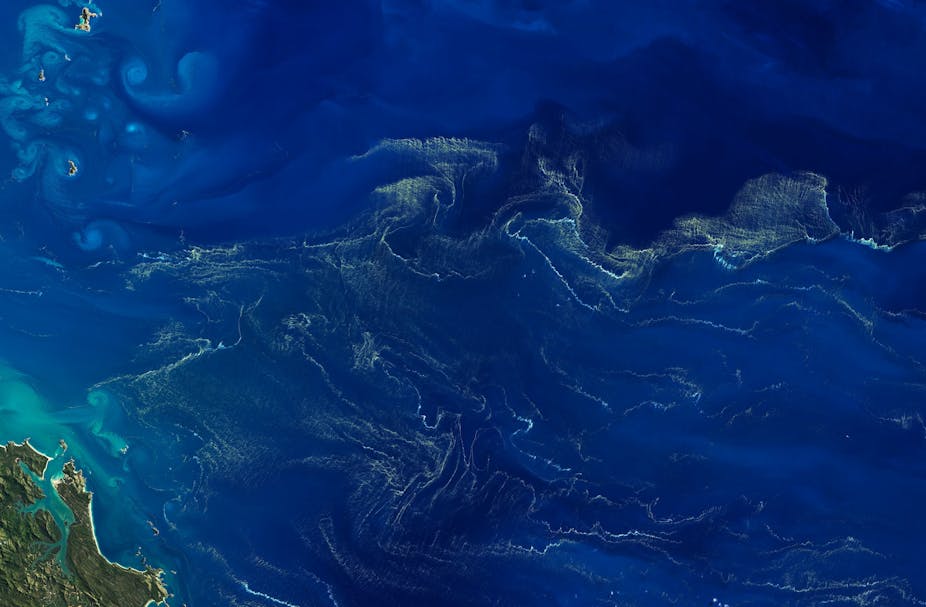The ocean absorbs a quarter of the CO₂ given out by human activities, playing a major role in slowing climate change. To have a better grasp of these processes is crucial to understand the ocean’s role in the global climate system and to better foresee disruptions caused by the changing climate.
Numerical modeling is among the most frequently used tools to do this. Through quantitive methods, it can simulate the interactions of important drivers of the climate, including atmosphere, oceans, land surface and ice. It represents the climate on a virtual planet earth, and is indispensable to explore past and predict future conditions, and to understand how our current climate works.
The challenge of modelling the oceans
These models rely on a series of equations governing the main physical, chemical and biological phenomena shaping the world’s climate. The difficulty of representing these forces comes from the complexity of simulating the physical and biological processes involved and how they interact with each other.
As far as the physics of the oceans is concerned, the equations are fairly well known and defined. Improving models depends above all on higher resolution, limited for the moment by the processing capacity and storage space of our computers.
When it comes to biological factors, however, there are lots of questions around how best to encode and simplify processes of the highest complexity. To boil it down: CO2 capture is principally regulated by phytoplankton. These microscopic algae live on the surface areas of the ocean and absorb CO2 via photosynthesis. When phytoplankton die, some of the organisms fall to the bottom of the ocean, providing a carbon store for hundreds, indeed thousands of years.
To represent phytoplankton, one of the commonest approaches is to divide it into “functional types” – that’s to say distinct groups of phytoplankton which have features in common such as size or feeding strategy. This approach assumes each type can have a different impact on the carbon cycle and play a different role in the ecosystem.
Diazotrophs – allies of the climate
One type in particular, diazotrophs, are under the spotlight at the moment. These organisms, as their name indicates, use nitrogen (N2) molecules for their growth (etymologically speaking, for feeding, from the Greek word trophos). By transforming N2, diazotrophs provide nutrients that are essential to other phytoplankton and allow them to photosynthesise. They thus have a fundamental role as natural fertilisers of the ocean.
Recent studies, in the field and the lab, have shown the great diversity of diazotrophs and their adaptation to different environments. For example, while it was previously thought diazotrophs were confined to warm, clear tropical waters, some unicellular diazotrophs have been discovered in Arctic seas or in the darkness of the deep ocean.
For a long time, however, researchers have taken the view that diazotrophs contribute little to carbon sequestration, because Trichodesmium – historically the most studied diazotroph – tends to stay on the ocean surface and to be little subject to predation. But evidence has been gathered and shows other types of diazotroph (those in symbiosis with diatom algae) are involved in significant carbon flows toward the depths).
Despite their importance, diazotrophs are often represented in a very sketchy way in numerical models. This is a result of both our understanding of their physiology still being limited, and constraints in computing capacity – when one adds complexity to the models, simulations take more time or need more powerful processors.
Many Earth System models, like those used by the Intergovernmental Panel on Climate Change, still work on the basis of assuming that nitrogen is artificially added to the ocean’s surface in certain conditions supposedly favourable to diazotrophs.
Other models explicitly represent the nitrogen-fixing process, but restrict themselves to a single type of diazotroph with the characteristics of Trichodesmium. This is, however, a very reductive approach given scientific advances, and limits our capacity to capture the global distribution of microalgae, assess their impact on the rest of the ecosystem, and to predict the consequences of climate change both on phytoplankton and carbon sequestration.
Better representation of diazotrophs in digital models
To address these gaps, we have developed within the framework of project NOTION a brand new representation of diazotrophs, this time including three different types.

If the equations describing diazotroph growth and mortality are the same, each type is distinguished from the others by specific factors, corresponding to how each type reacts to different temperatures, amount of sunlight or availability of nutrients.
This innovative representation of diazotrophs has been integrated into a high-resolution numerical model applied to the Atlantic Ocean – a diazotroph hotspot.
Accounting for the diversity of diazotrophs has resulted in an expansion of nitrogen fixing in digital models of the ocean, and closer accordance with field observations. Estimates of vertical carbon flows have also increased, notably in regions like the tropical West Atlantic, where diazotrophs in symbiosis with diatom algae flourish.

The new model allows us to address understudied issues, such as competition between diazotrophs, but also to better understand the role microalgae play in the context of a changing planet. What is their importance as a source of nitrogen going to be for other producers at the bottom of the food chain? Can diazotrophs help limit the effects of climate change? The possibilities for further research opened up by this more realistic representation are huge.
The NOTION research project described in this article is generously supported by Foundation BNP Paribas as part of its Climate and Biodiversity Initiative.
Translation by Joshua Neicho


